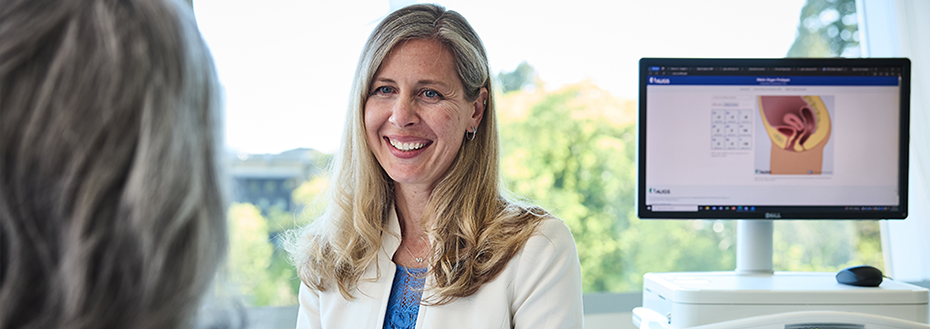Urogynecology and Reconstructive Pelvic Surgery

Expert care for pelvic floor disorders
The OHSU Center for Women’s Health offers the region’s most advanced care for urine leaks, pelvic prolapse and other pelvic floor disorders.
We can restore your comfort and confidence, and help you return to the activities you love.
You’ll find:
- The region’s most experienced team of women’s pelvic floor experts
- Thorough evaluation using the latest tests and technology
- Leading-edge care tailored to your condition
- Precision surgery for less pain and faster recovery
- The latest research advances and clinical studies
Conditions we treat
We treat conditions that affect the uterus, bladder, rectum and vagina. These conditions are common, especially after childbirth or later in life. They can cause urine or fecal leaks, vaginal bulging and disruptions to your regular activities.
Conditions we treat include:
- Urinary incontinence and overactive bladder
- Fecal incontinence
- Pelvic organ prolapse
- Fistula, an abnormal connection between the vagina and another pelvic organ, like the bladder
- Urethral diverticulum, when a pouch forms in the urethra, the tube that carries urine out of the body
Complete care
We give you complete care for all your pelvic health needs in one welcoming place.
Pelvic floor disorders can involve multiple organs and conditions. That’s why we don’t just treat your symptoms. We work as a team to find and treat all the issues that might be causing them.
Your team may include specialists in:
- Physical therapy
- Surgery
- Menopause and sexual health
- Urology
- Digestive health (gastroenterology)
- Nervous system (neurology)
Our services include:
- Advanced tests. We diagnose your condition using special tests such as 3D ultrasound.
- Effective non-surgical care options. We offer physical therapy, medication and more.
- Minimally invasive surgery and robotic surgery. We use tiny incisions, so you heal faster.
- Leading-edge treatments for urinary incontinence. For example, we offer nerve stimulation.
- Clinical studies. You may participate in research studies testing new treatments.
What to expect
Your symptoms may be embarrassing or difficult to talk about. We know what you’re going through, and we can help. Your privacy and comfort are our priority.
Before your first visit: Please fill out patient questionnaires through MyChart. These will include a diary to track what and how much you eat and drink and how often you use the bathroom in 24 hours.
At your first appointment, we will talk with you about:
- Your health history
- Your symptoms
- What you have tried already
- Possible tests
- Your care options
Pelvic exam: Your care provider will check the strength of your muscles, the support for your organs, and any painful sites. We may ask you to lie down and stand up to see the placement of your organs.
Planning your care: You may have several options, including surgery. We listen to your preferences and create the best care plan for you.
Next steps: We will help you schedule your tests and treatments and explain each one in detail.
Our excellence
We are the most experienced pelvic floor specialists in Oregon and Southwest Washington. Our doctors are national leaders and they bring the most advanced care to you.
- Our urogynecologists have three years of fellowship training in pelvic floor dysfunction.
- Our team follows the best care practices and keeps current on the latest research.
- Our team uses the latest tests, tools and surgical techniques and technologies.
For patients
Call 503-418-4500 to make an appointment.
Location
OHSU Center for Women’s Health, Marquam Hill
Kohler Pavilion, seventh floor
808 S.W. Campus Drive
Portland, OR 97239
Free parking for patients and visitors
Refer a patient
- Refer your patient to OHSU.
- Call 503-494-4567 to seek provider-to-provider advice.
FAQ and Resources
Find answers to common questions and links to national resources.